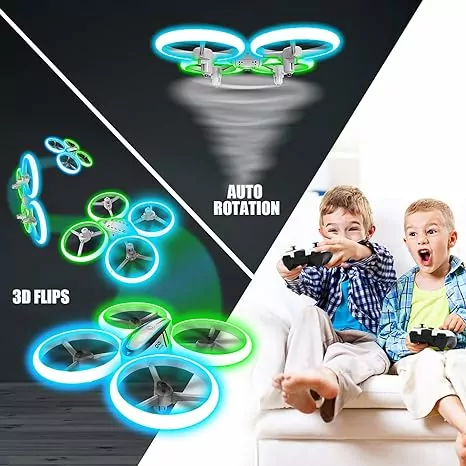Thanks to fast development in drone technology, beginners will find it simpler than ever to fly. Headless mode is one capability that entry-level drones find growing appeal. This creative flying mode streamlines the control system, therefore enabling rookie pilots to use their drones more naturally. We will explore in great detail in this extensive guide what headless mode is, how it works, its advantages, and pointers for applying it successfully.
Conventional Drone Control

Understanding how drones usually run without headless mode can help one to grasp the idea of it. Under a conventional control system, the drone moves relative to its orientation. The drone goes in the direction its front end is pointing when you push the right stick forward, therefore perhaps not always in line with your viewpoint as the pilot. For newcomers, especially if the drone is far away or facing you, this can be perplexing.
How This Work?
Headless mode solves this by precisely matching your controller’s orientation with the drone’s “head,” or front end. Regardless of the direction the drone is actually facing, when triggered, its motions match the direction you put the control sticks in. Pushing the right stick forward, for instance, constantly sends the drone away from you; pulling it back brings the drone toward you. This removes the necessity to mentally change your controls depending on the direction of the drone.
Advantages
Simplified Program of Control
Simplified control system is one of the main benefits of headless mode. Especially for novices, flying the drone becomes considerably easier when you match its motions with your controller. You no longer have to consider the drone’s orientation or mentally change your controls. For inexperienced pilots, this can greatly lower the learning curve and increase their enjoyment of flying.
Improved Situational Awareness
Additionally enhancing your situational awareness while flying is headless mode. You can concentrate more on your surroundings and the drone’s position relative to yourself when you are free from continual thinking about its orientation. When flying in close quarters or negotiating obstacles, this is especially helpful since it lets you make quick, simple changes to prevent crashes.
Minimized Confusion
Headless mode also helps to lessen confusion, particularly in cases of distance from the drone or loss of view of its front end. Under these conditions, it can be difficult to ascertain the drone’s orientation and how best to operate it. Engaged in headless mode, you can just push the control sticks in the intended direction and the drone will react accordingly, therefore facilitating control and allowing you to safely bring the drone back to you.
Guidelines for Maximizing Headless Mode Effectiveness
Correct Starting Conditions
Properly initializing your drone before flight will help to guarantee headless mode operates as expected. Most drones need you to activate headless mode by pointing them away from you. This lets the drone determine its starting orientation and match its motions to your controller. Ignorance of proper drone setup can lead to unexpected behavior and reduce the efficiency of headless mode.
Experience in Open Areas
First learning to fly in headless mode, it’s imperative to practice in open space devoid of hazards. This lets you become at ease with the controls and know how the drone reacts to your inputs without running afoul of obstacles. You can progressively advance to more demanding settings as you grow confident.
Preserve Visual Line of Sight
Even if headless mode can be useful when the drone is far away or difficult to view, always keep visual line of sight with your drone. This guarantees you’re following local rules and flying safely as well as helps you monitor the drone’s whereabouts. Should you lose sight of your drone, headless mode will help you to navigate it back to your position.
Combine with Other Flight Modes
For novices, headless mode is a great tool; yet, it’s also necessary to understand other flight modes. Try flying in standard mode as you grow experienced to improve your awareness of drone direction and control. To improve your flying skills and safety, you can also play around with other functions such as altitude hold, GPS location, and return-to-home.
Headless Mode Availability
Starting-Level Drones
Budget-wise and on entry-level drones, headless mode is most typically found. For beginners, manufacturers sometimes highlight this ability as a selling factor since it makes flying less scary and more approachable. For inexperienced pilots, popular models like the Ryze Tello, Potensic A20, and Snaptain S5C all feature headless mode, which makes them great options.
Advanced Flying Robots
Headless mode gets less prevalent as you climb to more sophisticated and costly drones. Usually made for seasoned pilots who have learned the fundamentals and are at ease with ordinary controls, these drones are less reliant on headless mode. However, some high-end drones, such as the DJI Mavic Air 2, do have similar capabilities like “Home Lock” or “Course Lock,” which combine the advantages of headless mode with more sophisticated maneuvers.
Specific Activation Based on Models
Different drone types will activate headless mode in different ways. While some drones have a dedicated button on the controller, others call for you to use a smartphone app or execute a particular stick sequence. Refer to the user handbook of your drone for particular directions on how to correctly turn on and operate headless mode.
FAQ
Is This Meant Solely for Novices?
Although headless mode is especially helpful for beginners, even experienced pilots can gain from it in some circumstances, such as flying in close quarters or when the drone is far away.
Can I Fly and Then Switch to Regular Mode?
Most drones let you turn on and off headless mode throughout flight. To prevent ambiguity and possible collisions, it is advised, nevertheless, to land the drone before changing modes.
Does This Operate with First-Person View Flying, or FPV?
Indeed, headless mode can be utilized in concert with FPV flight. When negotiating challenging terrain or when the drone’s orientation is difficult to follow via the FPV stream, it can be particularly beneficial.
Will Headless Mode Stop Crashes?
Headless mode is not perfect even if it might simplify and increase intuitive flying. Pilots still have to keep appropriate control of the drone and be aware of their surroundings to prevent collisions.
Can I Fly Autonomously ?
Headless mode does not influence autonomous flying characteristics including waypoint navigation or return-to-home; it is intended for hand control.
Conclusion
For first-time drone pilots, headless mode is a game-changing capability since it streamlines the control system and increases flying simplicity. Headless mode lowers the learning curve and lets pilots concentrate on enjoying the flying experience by matching the drone’s motions with the direction of the controller. Headless mode can be a useful tool for gaining confidence and negotiating difficult circumstances, even if it’s not a replacement for appropriate training and practice.
Mastering additional flight modes and techniques is crucial as your drone piloting path develops to help you to be a responsible and well-rounded operator. Nonetheless, in some situations, even experienced pilots might profit from headless mode, hence it is a characteristic of great importance while selecting a drone.
Knowing how headless mode operates, its advantages, and how to use it efficiently will help you to maximize this novel technology and improve your drone flying experience. Thus, test headless mode and see how it could improve your flying adventures, regardless of your level of experience—whether a novice just starting or an experienced pilot wishing to broaden their skills.

